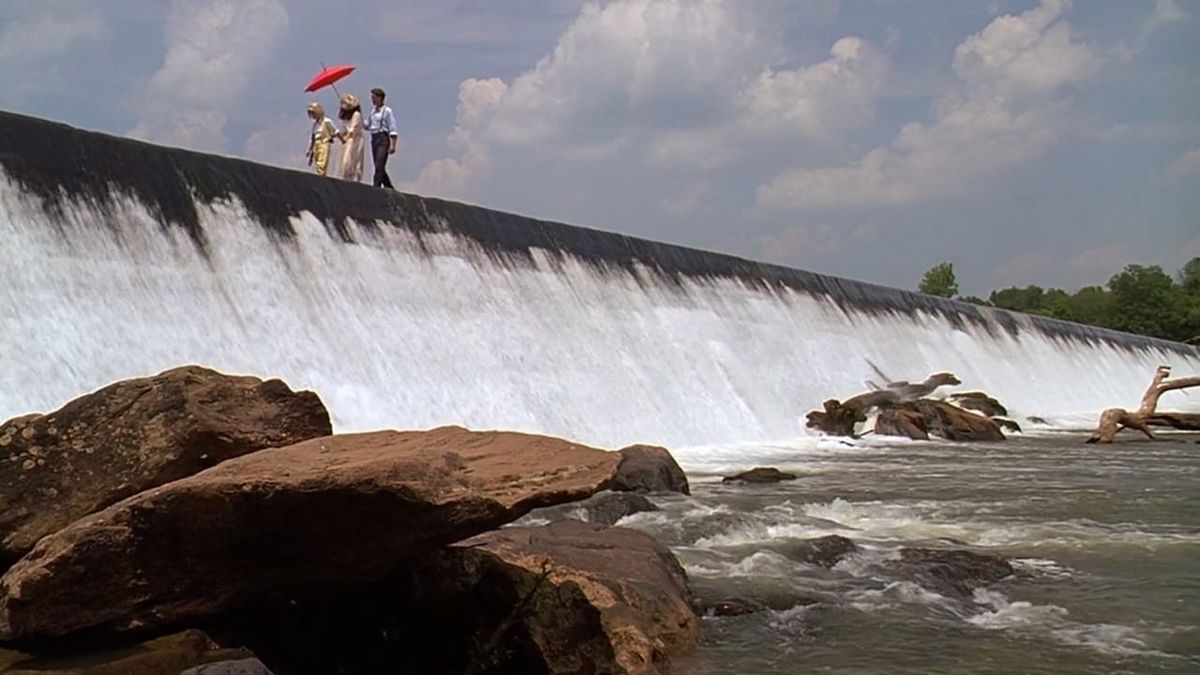
Returning to Faith—or Rejecting It?
The river baptism scene in Fried Green Tomatoes unfolds quietly, almost tenderly, but its emotional impact is monumental. Set during Ruth’s early days in Whistle Stop after escaping her abusive husband, the moment captures the community coming together in a symbolic act of cleansing and renewal. At its center is Idgie—watching from the margins.
The preacher dips Ruth into the water, surrounded by smiling neighbors and friends. The river reflects the late afternoon sun, glistening like liquid grace. For many in the town, this baptism is a reaffirmation of faith. For Ruth, it may be the first moment she truly feels safe again. But for Idgie, it’s far more complicated.
Idgie sits on the banks, physically present but spiritually distant. She doesn’t participate. She doesn’t sing. Her body language is defiant, closed off, skeptical. In this single moment, the film draws a line between these two women—not of affection, but of belief.
Idgie’s Complex Relationship with Faith
This is not the first time we see Idgie’s discomfort with religion. Earlier in the film, she storms out of her brother Buddy’s funeral, unable to accept the platitudes offered by the preacher. Her rebellion isn’t just against authority or tradition—it’s rooted in grief, in injustice, in a refusal to find peace where there has been none.
The river scene quietly reminds us of this wound. While others find solace in ceremony, Idgie resists it. Her truth lies elsewhere—in the wild woods, in storytelling, in acts of service. Religion, with its rigid rules and gender roles, has never offered her a home.
So when she watches Ruth get baptized, it’s not jealousy or judgment we see on her face. It’s loss. It’s longing. It’s the realization that even the person she loves most might still belong to a world she cannot enter.
Ruth’s Quiet Strength

Ruth, in contrast, surrenders to the moment. Not as an act of submission, but as an assertion of her own journey. She has left behind a violent marriage. She is building a new life. The baptism is her way of saying, “I am still here. I am reclaiming my soul.”
She doesn’t do it for others. She does it for herself. This distinction is important. Ruth is not naive. She is aware of the power of appearances in a small southern town. But she’s also deeply sincere. Her faith, like her gentleness, is a form of strength—not weakness.
This contrast between Idgie and Ruth is one of the film’s most moving dynamics. Ruth believes in God. Idgie believes in Ruth. And somehow, that’s enough.
Nature as Sacred Space
Though Idgie does not kneel in the river, the film subtly suggests that her spirituality takes a different form. She lives among the trees, sleeps under the stars, and finds purpose in feeding others and fighting injustice. Her connection to the divine is rooted in action, not dogma.
The river itself becomes a symbol of this paradox. It belongs to no one religion. It cannot be owned or divided. In that water, Ruth finds healing, and Idgie bears witness. It’s not a conversion scene. It’s a communion.
A Moment of Foreshadowing
The baptism also serves as subtle foreshadowing. Water will appear again in key emotional beats—when the café burns, when Ruth dies, when Idgie remembers. It marks transformation.
For Ruth, this scene is a beginning. For Idgie, it’s a crossroads. She must decide whether to stay outside or take the risk of walking beside someone, even if it means stepping into the unknown.
That risk will define their relationship for the rest of the story.
Acceptance Without Assimilation
One of the most beautiful aspects of the film is its willingness to let these two women differ without drifting apart. Ruth never tries to change Idgie. Idgie never mocks Ruth’s faith. They live with and love each other fully, without demanding sameness.
In a world that often insists on conformity, this river scene offers something radical: a portrait of acceptance. Idgie doesn’t need to be baptized to be saved. Ruth doesn’t need Idgie to believe what she believes. They find meaning not in merging, but in standing beside one another, fully themselves.
The Audience’s Gaze
Viewers often overlook this scene because it’s quiet. There’s no shouting, no drama. But its emotional resonance lingers. It challenges us to consider how we process transformation—what faith looks like when it’s not loud, what love looks like when it respects difference.
In an age where so many stories push for resolution, the baptism scene dares to remain unresolved. Idgie never gets in the water. Ruth never asks her to. And yet, they emerge from the moment closer than ever.
Conclusion: Grace from the Riverbank
The river baptism scene in Fried Green Tomatoes is not about religion—it’s about redemption. It’s not about belief—it’s about belonging.
Idgie and Ruth, standing on opposite sides of faith, still find a way to walk together. In that shared silence, in that sunlight on the water, we see the heart of the film: love that transcends language, ritual, and fear.
Not every moment of salvation needs a sermon. Sometimes, it just needs someone watching from the riverbank, willing to stay close, even in silence.
